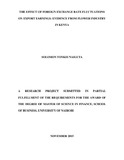| dc.description.abstract | This study evaluated the effect of foreign exchange rate fluctuations on exports earnings
with evidence from the flower industry in Kenya. The study used quarterly secondary
data which was gathered from HCDA, KNBS, KFC, EPC and CBK for a period of ten
years (2005 – 2014). The data collected was processed, analyzed, interpreted and
presented in such a manner that is clear, precise and unambiguous. This data was
quantified and coded using descriptive statistics. The statistical package for social
sciences (SPSS 22.0) was used to describe the collected data, sort and sift through and
analyze it. The results from the model show reliability of the model. The study indicated
that the variations in export earnings in the flower industry in Kenya are explained by
changes in foreign exchange rates, inflation rates and interest rate. The empirical results
showed that there was a strong positive relationship between the study variables: the
foreign exchange rate, inflation rate and interest rate. The regression results revealed that
there is a positive relationship between dependent variable (log of total export earnings of
the flower industry) and independent variables (foreign exchange rate, inflation rate,
interest rate). From these results, the study recommended that policy makers need to
maintain a robust exchange rate regime that will ensure a non-volatile behaviour. Policy
measures aimed at mitigating the high exchange rate volatility to promote flower exports
from Kenya need to be instituted. In order to cushion exporters from high exchange rate
fluctuations, the government could set up a flower export stabilization facility. The fund
could be capitalized by charging exporters a tax so that during periods of high flower
prices and high export earnings, the country would accumulate the fund which it would
draw down during periods of low flower prices. The flower price stabilization fund would
be introduced by the government through imposition of a tax on exports. This fund would
ensure predictability in flower prices so that fluctuations would not affect flower
exporters drastically in future. There is need for policy makers to work towards
increasing the volume of exports through diversification of market destinations by
targeting local, regional and export markets as opposed to the current practice. This can
be realized through regional and export market promotion initiatives as well as consistent
compliance with quality standards. Innovative ways of meeting the standards and
facilitation of smallholder farmers to meet these standards is required. In addition, Flower
export promotion incentives such as input subsidies and tax concessions need to be
considered. To reduce the relative price of flower exports from Kenya, there is need for
structural reforms that contribute to increased productivity and the enhancement of
international competitiveness. | en_US |

